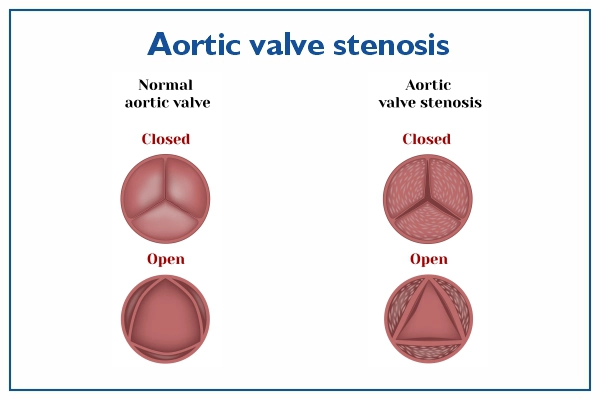Aortic valve Stenosis ( Heart Valve Surgery)
Aortic valve Stenosis is a build-up of calcium deposits on the valve, which reduces the blood circulation to the rest of the body. Aortic valve Stenosis constrains the flow of blood from the left ventricle to the aorta but may also affect the pressure in the left atrium.
Symptoms of Aortic valve Stenosis:
These may also be symptoms of heart failure. If you have any of these symptoms and have been diagnosed with heart failure, ask your doctor for an Aortic valve Stenosis test as well.
- Shortness of breath
- Fatigue
- Difficulty walking short distances
- Lightheadedness, dizziness, and fainting
- Swollen ankles and feet
- Rapid heartbeat
- Chest pain
What are the Risk factors of Aortic valve Stenosis?
Factors associated with the aortic disease include:
- Increasing in age
- High blood pressure
- High cholesterol
- Smoking
- Deformed aortic valve
- Family history
What Causes Aortic valve Stenosis?
- Calcium build-up on the valve :
Heart valves may accumulate calcium deposits with age.
- Birth defect :
Some people are just born with an aortic valve with only one or two leaflets instead of three leaflets. It may not cause any trouble until adulthood, when the valve may begin to narrow or leak.
- Rheumatic fever :
It may result in scar tissue on the aortic valve, which could restrict the aortic valve or create a rough surface where calcium deposits can be collected.
Who’s affected by Aortic valve Stenosis?
Aortic valve Stenosis is a common public health problem that affects millions of people around the world. It is estimated that up to 12.4 per cent of people over 75 years of age have Aortic valve Stenosis. Approximately 80% of adults with symptomatic Aortic valve Stenosis are male.
What happens to a person who has Aortic valve Stenosis?
Over time, your aortic valve leaflets become stiff, reducing their ability to fully open and close. If the leaflets are not fully opened, your heart will have to work harder to push blood through the aortic valve to your body. Eventually, your heart will become weaker, increasing the risk of heart failure.
Diagnosis for Aortic valve Stenosis
- Auscultation : The cardiologist will be using a stethoscope to listen to the sound of the heart.
- Electrocardiogram (ECG) :
Sensors are attached to your skin to measure electrical impulses emitted from your heart, displayed as waves on a monitor or printed on paper.
- Chest X-ray :
An X-ray image of your chest allows your doctor to check the size and shape of your heart. A chest X-ray can also reveal calcium deposits on the aortic valve.
- Echocardiogram :
This is also known as an ultrasound; it uses sound waves to create an image of your heart that helps your doctor examine the aortic valve closely.
Aortic valve Stenosis Treatment
Over time, your aortic valve leaflets become stiff, reducing their ability to fully open and close. If the leaflets are not fully opened, your heart will have to work harder to push blood through the aortic valve to your body. Eventually, your heart will become weaker, increasing the risk of heart failure.
There are two options for replacing your diseased Aortic Valve:
Transcatheter Aortic Valve Implantation (TAVI)
TAVI may be a better choice for people who are diagnosed with serious Aortic valve Stenosis depending on their risk of open-heart surgery. TAVI (sometimes called aortic valve replacement transcatheter or TAVR) is a quite invasive procedure than open-heart surgery. This procedure uses a catheter to implant a new valve inside your diseased aortic valve. TAVI can be performed through multiple approaches, but the most common approach is the transfemoral approach (through a small incision in the leg). Only professionals who have received extensive training are qualified to carry out the TAVI procedure. A properly trained and dedicated multidisciplinary Heart Team at the TAVI Center will conduct a thorough assessment to determine the most appropriate.
Open Heart Surgical Aortic Valve Replacement
Aortic valve replacement by open heart surgery is another option for the treatment of severe Aortic valve Stenosis. Most open-heart surgery is performed through an incision across the full length of the breastbone or sternum. Occasionally, heart surgery can be performed through smaller incisions. Open cardiac surgeries, including those performed through smaller incisions, both require the use of a heart-lung machine that temporarily takes over the function of the heart. The surgeon will completely remove the diseased aortic valve and insert a new valve during the procedure. There are two different types of surgical valves: mechanical (man-made material) and biological (animal or human tissue).
Citations

